Upgrading to a smart home can significantly enhance your living experience by improving convenience, security, and energy efficiency. To make the most of your investment, it’s essential to budget wisely, focusing on key features like smart thermostats, lighting, and security systems that align with your needs. By planning your upgrades carefully, you can enjoy the benefits of a connected home while keeping costs manageable.
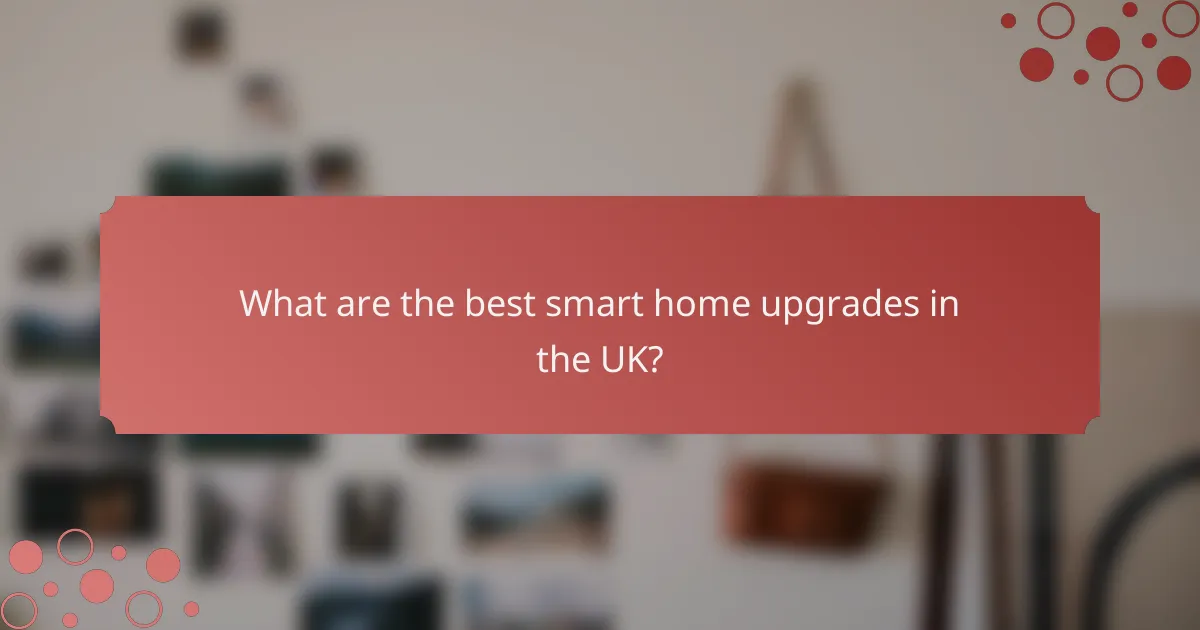
What are the best smart home upgrades in the UK?
The best smart home upgrades in the UK focus on enhancing convenience, security, and energy efficiency. Key features include smart thermostats, lighting systems, security cameras, speakers, and plugs, each offering unique benefits and varying costs.
Smart thermostats
Smart thermostats allow homeowners to control heating and cooling remotely, optimizing energy use and reducing bills. Popular models, such as the Nest Learning Thermostat, can learn your schedule and adjust temperatures accordingly, potentially saving up to 20% on heating costs.
When choosing a smart thermostat, consider compatibility with your existing heating system and whether it can integrate with other smart devices. Look for features like geofencing, which adjusts settings based on your location, ensuring comfort when you arrive home.
Smart lighting systems
Smart lighting systems enable you to control lights via smartphone apps or voice commands, enhancing convenience and energy efficiency. Brands like Philips Hue offer customizable options, allowing you to set schedules, dim lights, or change colors to suit your mood.
When upgrading, consider the initial investment versus potential savings on energy bills. LED smart bulbs typically consume less power than traditional bulbs, and many systems allow for remote control, which can help reduce energy waste when you’re away.
Home security cameras
Home security cameras provide peace of mind by allowing you to monitor your property remotely. Options range from indoor cameras to outdoor models with night vision and motion detection, with brands like Ring and Arlo leading the market.
When selecting a security camera, consider features like cloud storage, video quality, and ease of installation. Many systems offer subscription plans for additional storage and advanced features, which can impact your overall budget.
Smart speakers
Smart speakers, such as Amazon Echo and Google Nest, serve as central hubs for controlling other smart devices through voice commands. These devices can play music, provide weather updates, and even control your smart home systems, enhancing convenience.
When choosing a smart speaker, consider compatibility with your existing devices and the ecosystem you prefer. Some speakers offer better sound quality, while others may have more extensive smart home integration options.
Smart plugs
Smart plugs allow you to control standard appliances remotely, turning them on or off via an app or voice command. They are an affordable way to make existing devices smarter, with options available from brands like TP-Link and Wemo.
When purchasing smart plugs, check for features like energy monitoring and compatibility with your smart home ecosystem. They can help reduce energy consumption by allowing you to schedule devices to turn off when not in use, contributing to overall savings on your electricity bills.
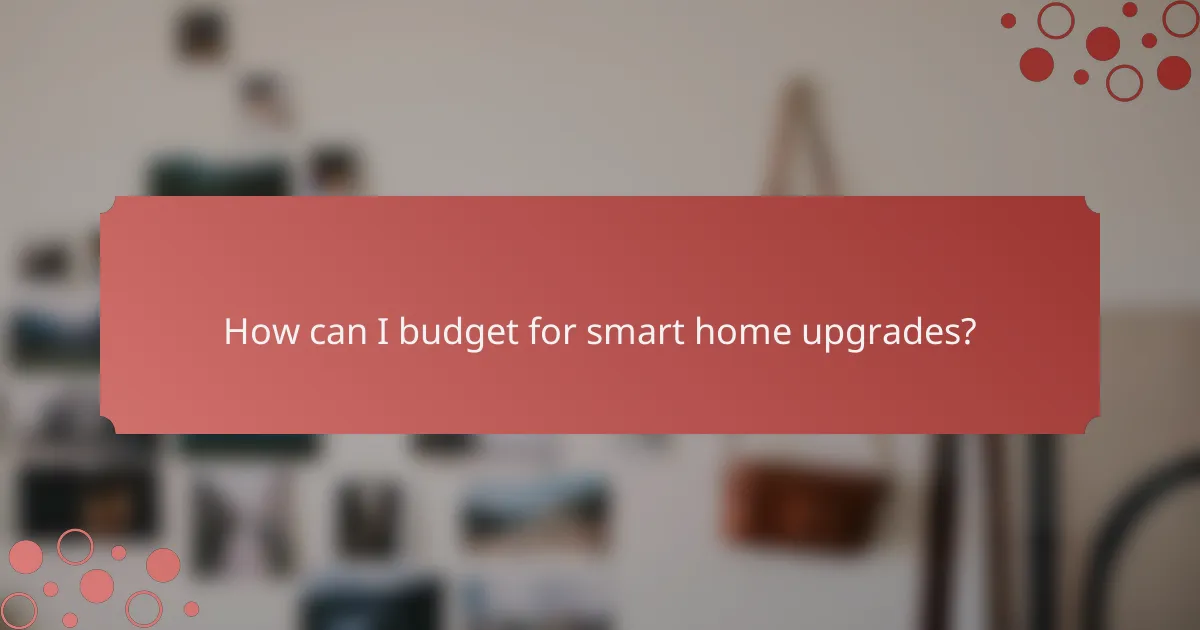
How can I budget for smart home upgrades?
Budgeting for smart home upgrades involves evaluating your current financial situation, determining how much you can spend, and identifying which features are essential for your needs. A clear plan will help you make informed decisions and avoid overspending.
Assess current expenses
Start by reviewing your existing monthly expenses to understand where your money goes. Look for areas where you can cut back, such as subscriptions or utilities, to free up funds for smart home investments. This assessment will provide a clearer picture of your financial flexibility.
Consider using budgeting tools or apps to track your spending habits. These resources can help you identify trends and pinpoint unnecessary costs, making it easier to allocate funds for smart home upgrades.
Set a realistic budget
Establish a budget that reflects your financial situation and the scope of your smart home project. A practical range for smart home upgrades can vary widely, from a few hundred to several thousand dollars, depending on the technology and installation requirements.
Include a buffer in your budget for unexpected expenses, typically around 10-20% of your total budget. This will help you manage any surprises without derailing your financial plan.
Prioritize essential features
Identify which smart home features are most important to you and your lifestyle. Focus on upgrades that enhance security, energy efficiency, or convenience, such as smart locks, thermostats, or lighting systems. Prioritizing these essentials will ensure you get the most value from your investment.
Consider starting with a few key devices and gradually expanding your system as your budget allows. This phased approach can help you manage costs while still enjoying the benefits of smart technology in your home.
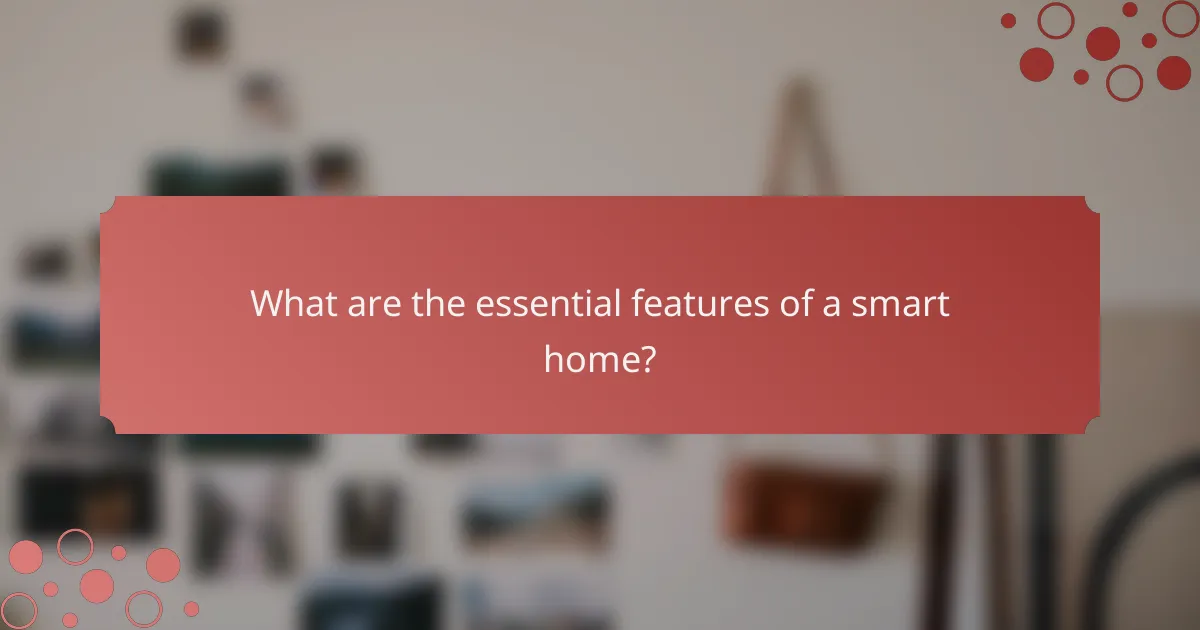
What are the essential features of a smart home?
The essential features of a smart home include remote access and control, energy efficiency, and home automation. These elements work together to enhance convenience, reduce energy consumption, and improve overall security.
Remote access and control
Remote access and control allow homeowners to manage their smart devices from anywhere using a smartphone or tablet. This feature is crucial for monitoring security cameras, adjusting thermostats, or turning lights on and off while away from home.
When choosing devices, look for those compatible with popular platforms like Google Assistant or Amazon Alexa. This compatibility ensures seamless integration and easy control through voice commands or mobile apps.
Energy efficiency
Energy efficiency in smart homes is achieved through devices that monitor and optimize energy usage. Smart thermostats, for example, can learn your schedule and adjust heating and cooling accordingly, potentially reducing energy bills by 10-20%.
Consider investing in smart lighting systems that automatically turn off when no one is in the room. This not only saves energy but also extends the lifespan of your bulbs, making it a cost-effective upgrade.
Home automation
Home automation refers to the ability to program and automate tasks within your smart home. This can include scheduling lights to turn on at sunset or setting your coffee maker to start brewing in the morning.
To maximize the benefits of home automation, create routines that align with your daily activities. For instance, a “Good Night” routine could lock doors, turn off lights, and adjust the thermostat, enhancing security and comfort with minimal effort.
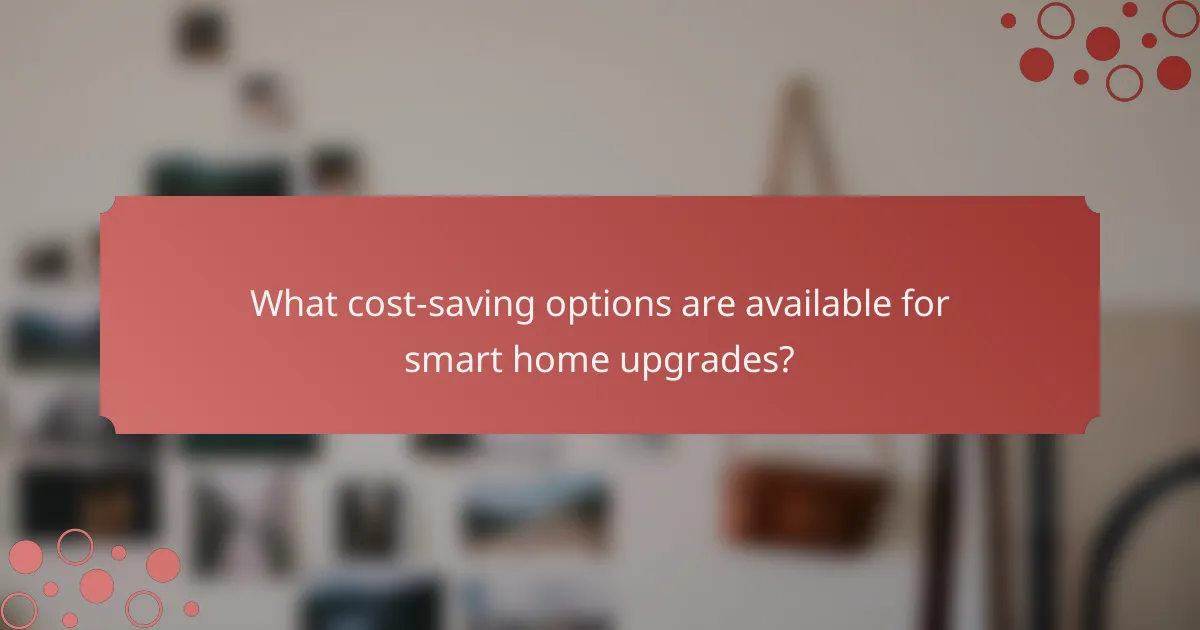
What cost-saving options are available for smart home upgrades?
Cost-saving options for smart home upgrades include DIY installation, energy-saving devices, and bundled smart home packages. These approaches can significantly reduce both initial investment and ongoing expenses while enhancing your home’s functionality.
DIY installation
Installing smart home devices yourself can save you substantial labor costs. Many products come with user-friendly instructions and require minimal tools, making them accessible for most homeowners. For example, smart bulbs or plugs can often be set up in just a few minutes without professional help.
However, be cautious with more complex systems like smart thermostats or security cameras, which may require additional technical knowledge. Always check compatibility with your existing home systems before purchasing.
Energy-saving devices
Energy-saving devices, such as smart thermostats and LED lighting, can lead to significant savings on utility bills. Smart thermostats can adjust heating and cooling based on your schedule, potentially reducing energy costs by 10-20%. Similarly, smart lighting systems allow you to control lights remotely and set schedules to minimize energy waste.
When selecting energy-saving devices, look for those with Energy Star ratings, as these are designed to meet energy efficiency standards. Investing in these devices can pay off quickly through lower monthly bills.
Bundled smart home packages
Bundled smart home packages often provide a cost-effective way to upgrade multiple aspects of your home simultaneously. These packages typically include a combination of devices such as smart speakers, cameras, and sensors at a reduced price compared to purchasing each item separately.
Before committing to a bundle, evaluate your specific needs and ensure the included devices are compatible with your existing systems. This approach can streamline your setup process and may offer better warranties or customer support options.

What are the prerequisites for smart home upgrades?
Before upgrading to a smart home, ensure you have a reliable internet connection and compatible devices. These prerequisites are essential for seamless integration and optimal performance of smart home technology.
Reliable internet connection
A strong and stable internet connection is crucial for smart home upgrades. Most smart devices rely on Wi-Fi to communicate with each other and with your smartphone or hub, so a broadband connection with good speed is recommended.
Consider a minimum download speed of 25 Mbps for a smooth experience, especially if you plan to connect multiple devices. If your home is large or has Wi-Fi dead zones, you might need to invest in a mesh network system to ensure coverage throughout your space.
Compatible devices
Ensure that the smart devices you choose are compatible with each other and your existing technology. Many devices operate on specific protocols like Zigbee, Z-Wave, or Wi-Fi, so check compatibility before purchasing.
For example, if you opt for a smart hub, verify that it supports the devices you intend to use, such as smart lights, thermostats, or security cameras. This compatibility will help you avoid integration issues and enhance the overall functionality of your smart home system.
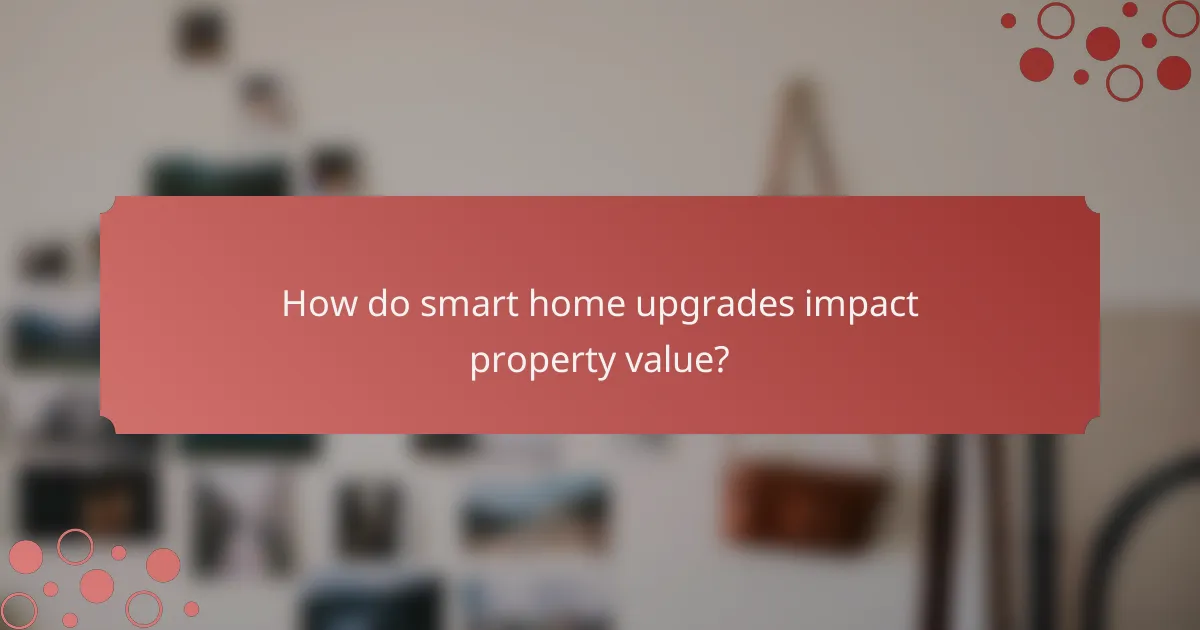
How do smart home upgrades impact property value?
Smart home upgrades can significantly enhance property value by making homes more appealing to potential buyers. These upgrades often lead to increased energy efficiency, improved security, and modern conveniences that are highly sought after in today’s market.
Increased market appeal
Smart home features can boost a property’s market appeal by attracting tech-savvy buyers who prioritize convenience and efficiency. Homes equipped with smart thermostats, security systems, and lighting can stand out in listings, making them more attractive compared to traditional homes.
Investing in popular smart home technologies can yield a return on investment (ROI) of around 10-20% when selling. Features like smart locks and video doorbells not only enhance security but also add a modern touch that resonates with buyers looking for contemporary living solutions.
To maximize market appeal, focus on upgrades that are widely recognized and valued, such as smart lighting systems and energy-efficient appliances. These features not only make daily life easier but also contribute to lower utility bills, which is a strong selling point for many buyers.
